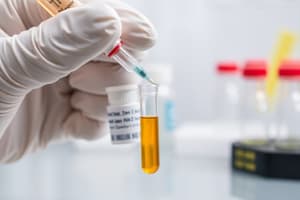Podcast
Questions and Answers
Analytical Microbiology uses microorganisms as reagents for ______ determination.
Analytical Microbiology uses microorganisms as reagents for ______ determination.
chemical
Assays can be classified as quantitative or ______ analysis.
Assays can be classified as quantitative or ______ analysis.
qualitative
A bioassay is used to determine the concentration of a substance by its effect on living ______.
A bioassay is used to determine the concentration of a substance by its effect on living ______.
organisms
The applied stimulus in biological assays can be standard or test samples containing a biologically active ______.
The applied stimulus in biological assays can be standard or test samples containing a biologically active ______.
An example of a biological system used in assays is ______.
An example of a biological system used in assays is ______.
The response observed in biological systems upon applying the analyte can be positive or ______.
The response observed in biological systems upon applying the analyte can be positive or ______.
Biological assays may lead to a response that is indicative of biological ______.
Biological assays may lead to a response that is indicative of biological ______.
Biologically active macromolecules, such as antibodies and ______, are also used in biological assays.
Biologically active macromolecules, such as antibodies and ______, are also used in biological assays.
A microbiological assay uses ______ as reagents for the determination of chemical compounds.
A microbiological assay uses ______ as reagents for the determination of chemical compounds.
In analytical microbiology, a measurable response is determined by the reaction of a suitable ______.
In analytical microbiology, a measurable response is determined by the reaction of a suitable ______.
The growth of a susceptible ______ can be inhibited by antibiotics like penicillin.
The growth of a susceptible ______ can be inhibited by antibiotics like penicillin.
Microbiological assays can be replicated without specialized and ______ equipment.
Microbiological assays can be replicated without specialized and ______ equipment.
Genetic variations have a negligible effect on microbiological assays because of ______ reproduction.
Genetic variations have a negligible effect on microbiological assays because of ______ reproduction.
Microbiological assays are limited when measuring analytes that either inhibit or promote microbial ______.
Microbiological assays are limited when measuring analytes that either inhibit or promote microbial ______.
Immunoassays utilize ______ because of their ability to bind foreign substances with specificity.
Immunoassays utilize ______ because of their ability to bind foreign substances with specificity.
A wide range of substances of biological and medical importance can be measured using various ______ methods.
A wide range of substances of biological and medical importance can be measured using various ______ methods.
Bioassays using ______ can be carried out by applying an analyte on the living organism.
Bioassays using ______ can be carried out by applying an analyte on the living organism.
Assays that use microorganisms are one of the three principal types of ______.
Assays that use microorganisms are one of the three principal types of ______.
Immunoassays involve the use of ______, which are macromolecules.
Immunoassays involve the use of ______, which are macromolecules.
One example of a bioassay is assessing the activity of a product containing vitamin D on ______.
One example of a bioassay is assessing the activity of a product containing vitamin D on ______.
The primary disadvantage of using whole animals or their tissues for bioassays is that they can be ______.
The primary disadvantage of using whole animals or their tissues for bioassays is that they can be ______.
Bioassays using animals should be regarded as a last resort, only when no valid ______ exist.
Bioassays using animals should be regarded as a last resort, only when no valid ______ exist.
The sensitivity of bioassays using whole animals or their tissues is often ______.
The sensitivity of bioassays using whole animals or their tissues is often ______.
Conducting assays on tissues requires them to be ______ removed from the animal.
Conducting assays on tissues requires them to be ______ removed from the animal.
The main advantage of certain analytical methods lies in their simplicity, specificity, and ______.
The main advantage of certain analytical methods lies in their simplicity, specificity, and ______.
A major disadvantage of these methods is that they require relatively expensive ______.
A major disadvantage of these methods is that they require relatively expensive ______.
An ideal test organism must be sensitive to the substance being ______.
An ideal test organism must be sensitive to the substance being ______.
The ideal test organism should preferably be ______.
The ideal test organism should preferably be ______.
Choice of a microorganism depends on the need of the ______.
Choice of a microorganism depends on the need of the ______.
Flashcards
Analytical Microbiology
Analytical Microbiology
A branch of microbiology using microorganisms as tools to quantitatively or qualitatively identify chemical compounds.
Assay
Assay
A qualitative or quantitative analysis of a substance using various methods, including biological assays.
Biological Assay
Biological Assay
An analytical method using living organisms (animals, plants, cells, macromolecules) to measure a substance's concentration or potency.
Bioassay
Bioassay
Signup and view all the flashcards
Stimulus
Stimulus
Signup and view all the flashcards
Biological System
Biological System
Signup and view all the flashcards
Response
Response
Signup and view all the flashcards
Microbiological assays
Microbiological assays
Signup and view all the flashcards
Advantages of microbiological assays
Advantages of microbiological assays
Signup and view all the flashcards
Disadvantages of microbiological assays
Disadvantages of microbiological assays
Signup and view all the flashcards
Test organism
Test organism
Signup and view all the flashcards
Ideal test organism characteristics
Ideal test organism characteristics
Signup and view all the flashcards
Factors influencing organism choice
Factors influencing organism choice
Signup and view all the flashcards
Microbiological Assay
Microbiological Assay
Signup and view all the flashcards
Analytical Microbiology
Analytical Microbiology
Signup and view all the flashcards
Growth-Promoting Substance (GPS)
Growth-Promoting Substance (GPS)
Signup and view all the flashcards
Growth-Inhibiting Substance (GIS)
Growth-Inhibiting Substance (GIS)
Signup and view all the flashcards
Immunoassay
Immunoassay
Signup and view all the flashcards
Antibody
Antibody
Signup and view all the flashcards
Advantages of Microbiological Assays
Advantages of Microbiological Assays
Signup and view all the flashcards
Disadvantages of Microbiological Assays
Disadvantages of Microbiological Assays
Signup and view all the flashcards
Bioassay
Bioassay
Signup and view all the flashcards
Animal Bioassay
Animal Bioassay
Signup and view all the flashcards
Microorganism Bioassay
Microorganism Bioassay
Signup and view all the flashcards
Immunoassay
Immunoassay
Signup and view all the flashcards
Analyte
Analyte
Signup and view all the flashcards
Biological System
Biological System
Signup and view all the flashcards
Biological response (in assay)
Biological response (in assay)
Signup and view all the flashcards
Animal Tissues (in bioassays)
Animal Tissues (in bioassays)
Signup and view all the flashcards
Sensitivity (in bioassays)
Sensitivity (in bioassays)
Signup and view all the flashcards
Specificity (in bioassays)
Specificity (in bioassays)
Signup and view all the flashcards
Study Notes
Analytical Microbiology
- Analytical microbiology is a branch of microbiology that uses microorganisms as reagents for quantitative or qualitative determination of chemical compounds.
- This determination is called an assay.
- If living systems are used (animals, plants or microorganisms) the assay is called a biological assay
- A bioassay is a way to determine the concentration or potency of a substance by its effect on living organisms (in vivo) or cells (in vitro).
Basic Principles/Aspects of Biological Assays
- A simple assay is a qualitative or quantitative chemical analysis of an agent/compound.
- Assays can be performed using physical, chemical, or biological methods.
- Biological methods, also known as bioassays, determine if a substance (analyte) generates a measurable response in a biological system (e.g. plants, animals, tissues).
Stimulus and Response
- A stimulus (analyte) is applied to a biological system (e.g., standard/test samples of plants, animals, tissues, cells, macromolecules).
- The biological system responds to the stimulus and this response is noted. This response is indicated by a change that is observed. This response can be positive (increased growth or activity) or negative (inhibition or killing of the biological system).
Types of Bioassay Procedures
-
Using animals or their tissues:
- Living animals are used to observe a measurable physiological response to the analyte.
- Examples include evaluating vitamin D activity on animal development.
- Tissues are used in assays if they can still respond to the active compounds within the sample when freshly removed from the animal.
-
Using microorganisms:
- Microorganisms are used as reagents for qualitative or quantitative determination of chemical compounds.
- A specific microorganism will respond to a specific chemical entity/analyte (e.g. antibiotic). This response (e.g. growth inhibition) allows for quantitative or qualitative estimation of a substance.
- There are many chemicals that can be assayed, including growth promoting and growth inhibiting compounds.
-
Using macromolecules (immunoassays):
- Antibodies are used for highly specific binding to foreign substances (e.g., antigens).
- These methods (immunoassays) are very specific, sensitive, and simple compared to other analytical methods, but may use expensive kits.
The Test Organism (Biological System)
-
The choice of microorganism is dependent on:
- The researcher's needs
- The type and quantity of substance to be assayed
- The desired response
- Time available for testing.
- Accuracy of required results.
-
A suitable test organism must
- Be sensitive to the substance being tested
- Be easily cultured
- Have a measurable response/function
- Not be susceptible to sensitivity variations
- Ideally nonpathogenic
Studying That Suits You
Use AI to generate personalized quizzes and flashcards to suit your learning preferences.





